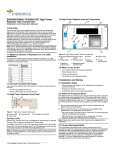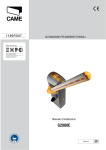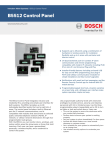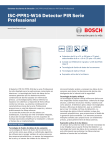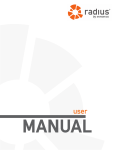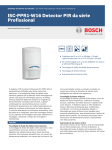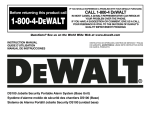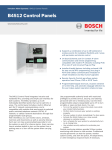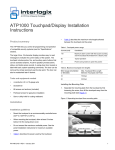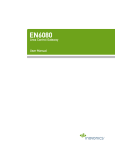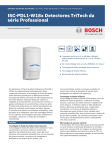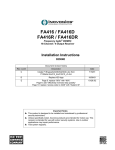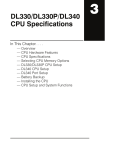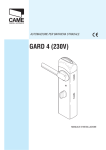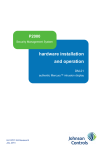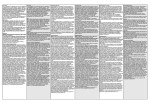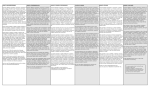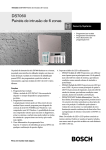Download EE1941/EN1941/EN1941-60 One-Way Binary RF Module
Transcript
EE1941/EN1941/EN1941-60 One-Way Binary RF Module Installation and Operation Manual 1 Overview EchoStream RF modules are designed to be easily interfaced with your electronic remote application controller (RAC). RF modules allow the assimilation of any user-specific application into an EchoStream system. Once integrated with existing products, RF modules provide you with complete EchoStream functionality. One-way binary RF modules are end-devices that use a logic-level connection to interface with your RAC. E*1941 one-way binary RF modules can be used in either one-way or two-way EchoStream systems. 2 One-Way Binary RF Module Components The E*1941 is a universal one-way binary RF module with two alarm input pins, allowing the use of dual inputs. Input one is the primary alarm, bit 0; input two is the secondary alarm, bit 1. There are two models in the E*1941 product family. • The EN1941 and EN1941-60, for 900 MHz applications in North America, New Zealand, and Australia. • The EE1941, for 868 MHz applications in Europe. A B C D Figure 1 One-Way System Components E F G Note: For UL 2560 installations, refer to the EN6080 Area Control Gateway H Installation Instructions or EN6040-T Network Coordinator Installation Instructions. 1.1 Maximum Number of Repeaters for a UL 2560 Installation To achieve the 99.99% alarm message reliability required for UL 2560 compliance, system installations must operate within the following limits for end device and repeater counts. End Devices Maximum Repeaters 150 397 250 386 350 375 500 360 1000 313 2000 238 3000 184 1.2 Inovonics Wireless Contact Information For product and installation videos visit us at www.inovonics.com/videos or use the QR code below. K L M I N J O Figure 2 One-Way Binary RF Module Components A Board stabilization hole. B Reserved C Reserved D Secondary alarm E Power F Ground G Primary alarm H LED contacts I Tamper input J Reset input K Frequency band selection pins L N/O selection pins M Mounting hole N On-board antenna O Board stabilization hole A B C D E F G K L M I N J O H Figure 3 EE1941 One-Way Binary RF Module Components If you have any problems with this procedure, contact Inovonics Wireless technical services: • E-mail: [email protected]. • Phone: (800) 782-2709; (303) 939-9336. 1.3 Installation Notes • These products are designed to be installed and maintained by professional security technicians. • Products are intended for indoor use. • Manually test all products weekly. 2.16.15 06287G © Inovonics, 2015 - www.inovonics.com A Board stabilization hole. B Reserved C Reserved D Secondary alarm E Power F Ground G Primary alarm H LED contacts I Tamper input J Reset input K ES selection pins L N/O selection pins M Mounting hole N On-board antenna O Board stabilization hole Frequency band selection pins (EN1941 and EN1941-60 only) Place a jumper to select the frequency band for your geographic area. • Place the jumper on the left two pins to select 915-928 MHz for Australia. • Place the jumper on the right two pins to select 921-928 MHz for New Zealand. • Leave the jumper off the pins to select 902-928 MHz for North America. ES selection pins (EE1941 only) To enable compatibility with ES products, place a selection jumper on the ES selection pins; if no ES products are used in your system, remove the selection jumper. N/O selection pins Place a jumper to select normally open inputs; remove the jumper to select normally closed. Note: The E*1941 is shipped with the jumper unattached. With the jumper unattached, the E*1941 defaults to normally closed. Secondary alarm Connects a secondary end-device to provide RF alarm data for any user-specific application. Primary alarm Connects a primary end-device to provide RF alarm data for any user-specific application. Tamper input Connects a tamper input to send a message when userspecific end-device is tampered with. Reset input Connects a reset input to reset the one-way binary RF module after a frequency band selection change or N/O - N/C selection change, and to initiate an RF transmission. Power Connect power cabling to an external power supply of 2.4 to 5.5 volts. Ground Connects to ground. Mounting hole Used to mount the one-way binary RF module to the userspecific product. The mounting hole should only be used with a nylon standoff, never metal. LED contacts Use to control an LED switch. Not designed to drive LED power. Board stabilization holes Used to mount and stabilize the board. The board stabilization holes should only be used with non-metal standoffs. 3 One-Way Binary RF Module Dimensions Clear transmit region in front and back of antenna RF module .515” to Center of Hole .156” Diameter .090” to Center of First Pin 5 Installation A Connecting the One-Way Binary RF Module B One-way binary RF modules are designed to be easily interfaced with your electronic remote application controller, however integration must conform to the following: C The RF module must only be connected at the eight pin header or eight pin plated through-holes. D All cables and wires must be routed away from the component side of the RF module. E The integrated antenna must not be tampered with; no connection to an alternate antenna is provided. F The application module must not include an integrated secondary collocated radio module. G The one-way binary RF module antenna should be placed so that it is facing away, or otherwise isolated from, your device’s ground plane. H Components that are sensitive to RF transmission, such as high gain circuits, should be isolated from the antenna to prevent interference. I One-way binary RF modules should not be mounted on metal surfaces or inside metal enclosures. They should also not be mounted where sheet metal ductwork, wire mesh screens, etc. might block transmissions. J The RF module should be integrated so the antenna is unobstructed by the end user’s PCB, batteries, or any other conductive material. .335” to Center of Hole 1.3” Pitch: 2.54mm. .385” to Center of First Pin End user application printed circuit board Figure 5 The RF module should be integrated so the antenna is unobstructed 6 One-Way Binary RF Module Requirements .5” 2.525” Figure 4 E*1941 One-Way Binary RF Module Dimensions 4 One-Way Binary RF Module Connections and Output Jumpers Connection Output Jumper N/O Output Jumper N/C Primary Alarm Open Alarm Clear Alarm Ground Alarm Alarm Clear Secondary Alarm Open Alarm Clear Alarm Ground Alarm Alarm Clear Open Alarm Alarm Ground Alarm Clear Alarm Clear Tamper Reset Open for normal operation; connect to the ground and release for a board reset. 2.16.15 06287G © Inovonics, 2015 - www.inovonics.com 6.1 Power Requirements The E*1941 has an on-board voltage regulator. Connect power cabling to an external power supply (Vcc) of 2.4 to 5.5 volts. Voltage must be sustained at 2.4 volts or above and supply 100 milliamps during the transmit cycle. 6.2 EN1941 and EN1941-60 Assuming check-in messages every 3 minutes and infrequent alarm messages (one per day, on average), the average current draw is 32 uA. Peak current draw while transmitting is less than 100 mA. One alarm/ restore cycle per hour results in about 5.3 uA increase in average current. EN1941 transmitters send a check-in message every three minutes; EN1941-60 transmitters send a check-in message every 60 minutes; Note: For UL 2560 installations, transmitters must have a minimum checkin time of 60 minutes. 6.3 EE1941 Assuming check-in messages every 12 minutes and infrequent alarm messages (one per day, on average), the average current draw is 15 uA. Peak current draw while transmitting is less than 50 mA. One alarm/restore cycle per hour results in about 5.3 uA increase in average current. 6.4 Low Battery Condition The E*1941 measures battery voltage every three and a half hours, and, when the battery measures 2.4 volts, a serial message is sent indicating a low battery condition. 6.5 Temperature range -40°C to +66°C, non-condensing 2 6.6 RF network compatibility EchoStream Commercial Mesh Network 6.7 Input Requirements Caution: Input levels must not exceed 3.3 V. Open When an active source (open collector or dry contact) is used to drive the alarm or tamper input, the voltage should be between 0.75xVcc and Vcc. A passive input should have an impedance of greater than 5.1k ohm between the input and ground. Closed When an active source is used, the voltage should be less than 0.25xVcc. A passive input should have an impedance of less than 240 ohm. 6.8 LED Requirements The LED output is an active output from the microprocessor, with a 1k series resistor to limit current draw. Default state is low, and the LED pin is pulled high during transmit. 7 Compliance Requirements 7.1 UL and cUL Requirements The module holds a UL and cUL Recognized Component Mark and is intended to be factory installed in another device, system or end-product. The suitability of the module for use in a UL and/or cUL listed (certified) device, system or end-product, is restricted as follows: • The EN1941 was evaluated as a UL/cUL Recognized Component compliant to selected requirements from UL639, ULC-S306-03, UL1076, ULC/ORD-C1076 and UL1610 as specified in the Conditions of Acceptability of the UL Report. • The Supply Line Transient tests shall be added to the RAC UL evaluation program if it is powered by an AC/DC adapter rather than a low voltage battery. • If intended use includes UL1610, UL1076 or UL639 installations, the RAC shall be evaluated for Short Range RF Device tests. • Compatible UL receivers (except for UL 2560) include EN4216MR, EN4232MR and EN7285. Refer to the EN4216MR Installation and Operation Manual, the EN4232MR Installation and Operation Manual or the EN7285 Installation Instructions. • The EN1941-60 is a UL2560 unlisted component. • The compatible receivers for UL 2560 installations are the EN6080 area control gateway and EN6040-T network coordinator. Refer to the EN6080 Area Control Gateway Installation Instructions and the EN6080 Area Control Gateway User Manual, or the EN6040-T Network Coordinator Installation Instructions. • The compatible repeater for UL 2560 installations is the EN5040-20T. • When selecting frequency band, only devices set for use in North America are configured for UL and cUL installations. • In a UL 2560 installation, the EN1941-60 one-way binary RF module may be used with completed emergency call systems for assisted living and independent living facilities • For UL 2560 certified system installations, the following Inovonics EchoStream devices are approved for installation within maximum system configuration limits defined in section 1.1 of this document: - EN6080 area control gateway or EN6040-T network coordinator. - EN5040-20T high power repeater. - End devices (transmitters) with a minimum 60-minute check-in interval, as follows: Fundamental devices which are subject to UL2560 certification (pendant transmitters and OEM products using the Inovonics RF module) Supplemental devices which are not subject to UL2560 system certification but which may be used within a UL2560 certified system (e.g. universal transmitters and activity sensors) • Users that have achieved certification and will install UL 2560 certified systems are responsible for labeling all fundamental devices with the UL 2560 system certification mark. Prior to marketing the product, the integrator must complete and submit to Inovonics a compliance review form and documentation, and, if requested, a functional product sample for approval. If this is not possible, the integrator must perform the testing themselves and submit proof to Inovonics of compliance to Part 15 of the FCC Rules and Industry Canada RSS-210. At the end of this guide is an Inovonics compliance review form to be filled out by the integrator. The integrator is also responsible for properly labeling the product containing the one-way binary RF module. Labels must be placed on the outside of the product, and must include a statement indicating that the product contains the module, along with the FCC and IC number. Example 1 “Contains One-Way Binary RF Module FCC ID: HCQ3B6OT9OEM; IC ID: 2309A-OT9OEM (EN1941-IC)” Example 2 “Contains FCC ID: HCQ3B6OT9OEM; IC ID: 2309A-OT9OEM (EN1941-IC)” 7.3 Television and Radio Interference This equipment has been tested and found to comply with the limits for a Class B digital device, pursuant to Part 15 of the FCC Rules. These limits are designed to provide reasonable protection against harmful interference in a residential installation. This equipment generates, uses and can radiate radio frequency energy and, if not installed and used in accordance with the instructions, may cause harmful interference to radio communications. However, there is no guarantee that interference will not occur in a particular installation. If this equipment does cause harmful interference to radio or television reception, which can be determined by turning the equipment off and on, the user is encouraged to try to correct the interference by one or more of the following measures: • Reorient or relocate the receiving antenna. • Increase the separation between the equipment and receiver. • Connect the equipment into an outlet on a circuit different from that to which the receiver is connected. • Consult the dealer or an experienced radio/TV technician for help. 8 FCC Part 15 and Industry Canada Compliance This device complies with part 15 of the FCC Rules and Industry Canada license-exempt RSS standard(s). Operation is subject to the following two conditions: (1) this device may not cause interference, and (2) this device must accept any interference, including interference that may cause undesired operation of the device. Le présent appareil est conforme aux CNR d'Industrie Canada applicables aux appareils radio exempts de licence. L'exploitation est autorisée aux deux conditions suivantes : (1) l'appareil ne doit pas produire de brouillage, et (2) l'utilisateur de l'appareil doit accepter tout brouillage radioélectrique subi, même si le brouillage est susceptible d'en compromettre le fonctionnement. 8.1 CE Label Requirements for EE1941 Inovonics Wireless has received European Telecommunications Standards Institute approval to market one-way binary RF modules, and they are manufactured to be RoHS compliant. The integrator is responsible for properly labeling the product containing the one-way binary RF module. Labels must be placed on the outside of the product, and must include the CE logo. Caution: Changes or modifications not expressly approved by the party responsible for compliance could void the user's authority to operate the equipment. 9 US Patent Numbers • • • • 7,154,866. 7,554,932. 7,746,804. Other patents pending. 7.2 FCC Requirements for the RF Module The one-way binary RF module has received a Limited Modular Grant, requiring Inovonics to retain control of the final installation to ensure compliance to FCC/IC regulations. The integrator is responsible to test the final installation to verify compliance to FCC/IC regulation for unintentional emissions. Changes or modifications not expressly approved by the party responsible for compliance could void the user's authority to operate the equipment. 2.16.15 06287G © Inovonics, 2015 - www.inovonics.com 3 Inovonics One-Way Binary RF Module Compliance Review Form Please provide the following information for review of final installation to ensure compliance with FCC/IC regulations: Required materials from integrator The following must also be attached for review with this form: • A description of the final installation, with attached photographs, as necessary •The unintentional radiator test report indicating compliance Integrator information First name: Last name: Phone number: Email address: Address: Declaration of conformity to Inovonics’ installation instructions: Submitted materials: Authorized signature: Submission date: Inovonics contact information Inovonics ATTN: Product Management 397 South Taylor Ave. Louisville, CO 80027 Phone: 303.939.9336 Toll-Free: 800.782.2709 Fax: 303.939.8977 [email protected] 2.16.15 06287G © Inovonics, 2015 - www.inovonics.com 4 Required materials from Inovonics • The record of product sample review and test, as necessary Inovonics approval First name: Last name: Phone number: Email address: Approval status (pass, fail, samples required, compliance testing required, compliance test report required): Approval comments: Submitted materials: Returned materials: Authorized signature: 2.16.15 06287G © Inovonics, 2015 - www.inovonics.com Approval date: 5





